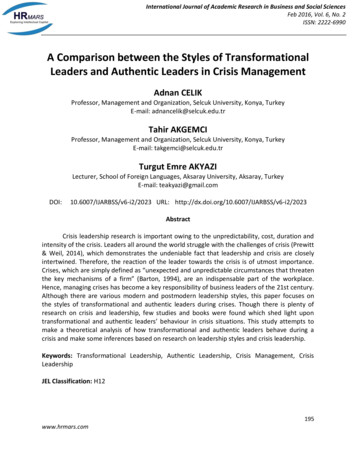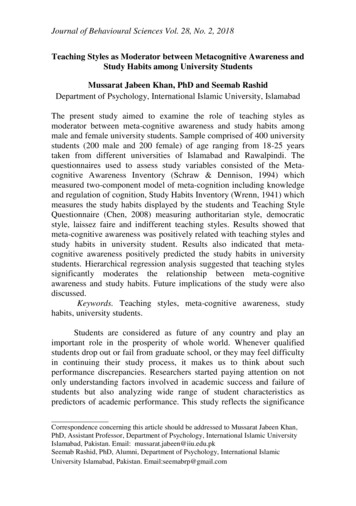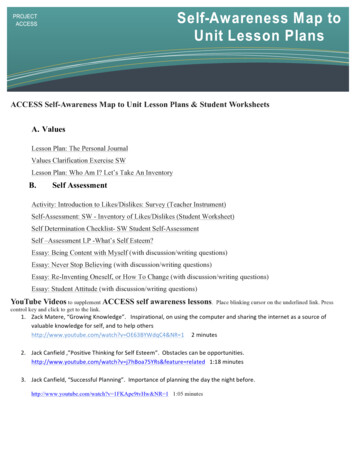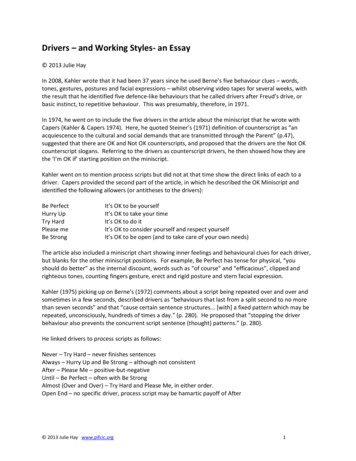
Transcription
International Journal of Academic Research in Business and Social SciencesFeb 2016, Vol. 6, No. 2ISSN: 2222-6990A Comparison between the Styles of TransformationalLeaders and Authentic Leaders in Crisis ManagementAdnan CELIKProfessor, Management and Organization, Selcuk University, Konya, TurkeyE-mail: adnancelik@selcuk.edu.trTahir AKGEMCIProfessor, Management and Organization, Selcuk University, Konya, TurkeyE-mail: takgemci@selcuk.edu.trTurgut Emre AKYAZILecturer, School of Foreign Languages, Aksaray University, Aksaray, TurkeyE-mail: teakyazi@gmail.comDOI:10.6007/IJARBSS/v6-i2/2023 URL: ctCrisis leadership research is important owing to the unpredictability, cost, duration andintensity of the crisis. Leaders all around the world struggle with the challenges of crisis (Prewitt& Weil, 2014), which demonstrates the undeniable fact that leadership and crisis are closelyintertwined. Therefore, the reaction of the leader towards the crisis is of utmost importance.Crises, which are simply defined as “unexpected and unpredictable circumstances that threatenthe key mechanisms of a firm” (Barton, 1994), are an indispensable part of the workplace.Hence, managing crises has become a key responsibility of business leaders of the 21st century.Although there are various modern and postmodern leadership styles, this paper focuses onthe styles of transformational and authentic leaders during crises. Though there is plenty ofresearch on crisis and leadership, few studies and books were found which shed light upontransformational and authentic leaders’ behaviour in crisis situations. This study attempts tomake a theoretical analysis of how transformational and authentic leaders behave during acrisis and make some inferences based on research on leadership styles and crisis leadership.Keywords: Transformational Leadership, Authentic Leadership, Crisis Management, CrisisLeadershipJEL Classification: H12195www.hrmars.com
International Journal of Academic Research in Business and Social SciencesFeb 2016, Vol. 6, No. 2ISSN: 2222-69901. INTRODUCTIONLeading in the twenty-first century is fairly different from leading in the twentiethcentury. Employees have changed dramatically — they no longer tolerate the classic “commandand control leaders” of the previous century. Likewise, they are not impressed by charismaticleaders whose leadership is based primarily on personal ego (Craig et al., 2015). Crisisleadership research is important owing to the unpredictability, cost, duration and intensity.Leaders all around the world struggle with the challenges of crisis (Prewitt & Weil, 2014).Crises are unexpected and unpredictable circumstances that threaten the keymechanisms of a firm (Barton, 1994). Crises are an indispensable part of the workplace.Therefore, managing crises has become a key responsibility of business leaders of the 21stcentury. Although there are various modern and postmodern leadership styles, this paperfocuses on the styles of transformational and authentic leaders during crises for two reasons.The first reason is that they are among the most prominent leadership styles studied in theliterature (Kim & Yoon, 2015). Besides, Avolio and Gardner (2005) argue that authenticleadership contains several aspects from transformational leaders. Another reason for choosingtransformational and authentic leadership is that these two leadership styles are the only stylesthat have been combined under a single style called “authentic transformational leadership”(Nichols, 2008). Besides, it is necessary that a leader be authentic in order to be viewed astransformational in both Bass’ (1985) and Burns’ (1978) conceptualizations. Transformationalleaders have been described as being hopeful, optimistic, developmentally-oriented, and ofhigh moral character, all of which describe authentic leaders (Avolio & Gardner, 2005; Nichols,2008).The paper aims to analyse the managerial styles of transformational and authenticleaders through a theoretical analysis of relevant research and draw conclusions regarding fromthe perspective of crisis leadership. The paper starts with the concept and scope of crisis andcrisis management. Then, transformational and authentic leadership are covered in detailbased relevant literature. Next, the styles of transformational and authentic leaders duringcrisis are handled, with examples and inferences based on previous research on contemporaryleadership styles crisis leadership. The final part of the paper involves several implications andsuggestions for further research.2. THE CONCEPT, SCOPE AND DIMENSIONS OF CRISISFrom a historical perspective, the concept of “crisis” can be classified into pre-industrialrevolution period, industrial society period and knowledge-information era. In the societies priorto the industrial revolution; yield loss, wars and epidemics were the primary sources of crisis.Cash flow problems posed a threat for the newly-established banks in pre-industrial revolutionperiod, which brought about numerous crises especially after 1825 (Seligman & Johnson, 1933).Economic crises resulted in social crises as well, which can be seen in some cases in certainEuropean countries. The 1825 stock market crisis, 1836 financial crisis and Panic of 1847 weredistinctive examples of such crises (Rosier, 1991). Nevertheless, developments in productionmanagement, reconstruction in industrial enterprises, increases in transportationopportunities, international interactions in the banking system and the acquisition of new196www.hrmars.com
International Journal of Academic Research in Business and Social SciencesFeb 2016, Vol. 6, No. 2ISSN: 2222-6990assets such as the gold mines in California and Australia changed the size of the pre-industrialrevolution crises. After the 1950s, the emergence of continuous manufacturing, developmentsin the mining sector and the rapid change in transportation and energy systems brought a newdimension in the concept of crisis called industrial society period. As a result of decrease inconsumption, insufficient production of gold, fall in the stock market and other financialproblems, City Bank of Glasgow, Western Bank of Scotland and The Banks of Maryland and ofPennsylvania experienced serious crises in the year of 1857. A decade later, in 1866 and 1867,Overand Gurney and Cre’dit Mobilier went through crises respectively during what is called“Black Friday” (Rosier, 1991). Finally, in the knowledge-information era, the US Motor Industryconfronted crises. Also, energy crisis came up as a result of growth crisis and the deflection ofconjuncture. Meanwhile, the underdeveloped countries which increasingly preferred to borrowmoney were not able to perform more export, which gave rise to difficulties in repayment(Balkan, 1994). In this last era of crisis conjuncture, the Stock Market Crash of 1987 has animportant position as well. Having occurred in October 1987, this crisis caused serious financialproblems. The negative effects of the crisis were diminished to a certain extent thanks toreflation policies, rebalancing mechanisms and especially liquidity increase (Rosier, 1991).2.1. The Concept and Scope of CrisisEtymologically derived from the Greek word “krisis”, the concept of “crisis” was used toindicate indecision, but afterwards the word became commonly used in many fields of medicaland social sciences (Seligman & Johnson, 1933). Various scholars proposed different definitionsof the term “crisis”. For instance, Ezzamel and Bourn (1990) defined crisis as “a moment whensurprises occur, time pressure is felt and a dangerous atmosphere is about to come up”. Celikand Ozdevecioglu (2002) defined crisis as a state whose symptoms are, for some reason,misunderstood although it sends warning signals beforehand. Steven On the other hand,Steven Fink (1996) defined crisis from an organizational perspective. He suggested that ifdisagreements are getting deeper and deeper, the pressure from the government and themedia is rising, activities are becoming inefficient, firm image is being harmed and it isbecoming more and more unlikely for the firm to achieve its purposes, then it means a crisishas showed up. Alan Weiss (1990) proposed a more broad definition. He claimed that theconcept of crisis is closely linked to certain negative situations and the effects they might haveon the organizational structure. Therefore, it would be reasonable to state that the concept ofcrisis is quite related to negative interactions among organizational structure, intraorganizational groups, employees and other environmental factors (Kaufman et al., 1994).Milburn et al. (1983) state three important processes regarding the scope of crisis andthe formation of organizational crisis: The atmosphere that lead to crisis: external and internal environment Reactions towards crisis: individual and organizational reactions Measures to be taken against crisis: steps that are taken in order to both preventand eliminate the crisis.Among the problems that might lead to organizational crises are product loss, factoryequipment losses, major industrial accidents, computer losses or damages, being subject to197www.hrmars.com
International Journal of Academic Research in Business and Social SciencesFeb 2016, Vol. 6, No. 2ISSN: 2222-6990hostile attacks, negative competition, sabotage, gossip, slander, bribery, managers’ quitting thejob and transferring to the competitors, insufficient staff management, terrorism and inefficientcommunication (Mitroff, 1988). Certain characteristics of crises are stated as follows (Kuklan,1986): Crisis resembles a severe disease. Often crises might bring about negative organizational outcomes such asuncertainty, anxiety, panic, etc. Crises might bear quite different characteristics. It must be taken into considerationthat every crisis has its own unique beginning, development and final stages. The solution to certain crises might take a lot longer than estimated. Crises might affect managers, employees, customers, suppliers, credit institutions aswell as states, tax payers and NGOs. Not all stressful circumstances (temporary competition, insignificant environmentalpressures) must be considered as crises. Many organizational and environmental developments might be considered ascause of crisis even if they do not pose a financial threat. A solution for a crisis might not be valid for another possible future crisis. Therefore,developing a single crisis model that could be used in every crisis situation is quitechallenging. Crises are more likely to occur depending on some circumstances such as the typeof industry, competition, technological advancements, risk strategies, etc. Much as crises are sources of threat for organizational life, enterprises that cansuccessfully overcome crises not only gain experience but attain a more strong andhealthy organizational structure as well. While an unsolved crisis contributes to thedestruction of an organization, another crisis that is managed effectively may bringabout various unexpected opportunities.2.2. The Concept and Scope of Crisis ManagementCrises are circumstances that are unexpected and unpredictable, require rapid response,and that threatens the values, goals and assumptions by neutralizing the prevention andadaptation mechanisms of the firm (Barton, 1994). Crisis management can be defined as theprocess of perception and assessment of crisis signals and implementation of necessarymeasures to overcome the crisis with minimum loss (Can, 1994).Crisis management practices involve activities such as the preparation of plans that willeliminate the negative factors that exist in the internal and external environment,arrangements that make it possible for the organizational structure to function in harmony andthe formation of decision making processes (Armstrong 1993). The main principles of crisismanagement (CM) are stated as follows (Barton, 1994): CM is an activity of planning. CM is related to strategic management. CM is related to marketing and public relations. CM involves risk management.198www.hrmars.com
International Journal of Academic Research in Business and Social SciencesFeb 2016, Vol. 6, No. 2ISSN: 2222-6990 CM requires not only the employment of crisis experts but also collectinginformation from relevant institutions. CM involves training programs. CM requires effective communication and coordination.Crises send out certain warning signals before they occur. Since these signals involvedetails about the existence and the severity of the approaching crisis, managers must beextremely mindful of these signals. Crises might come up due to the failure to follow thewarning signals (Can, 1994). Many incidents that might result in devastating consequencesdemonstrate themselves in a clear or tacit way beforehand. Several warning signals includeineffective cash management, lack of communication between shareholders and managers,transfer of management to rival firms, etc. (Regester, 1989). Another possible source of crisis isfailure to predict the amount of future demands. In order to predict future demand, firms canconduct surveys, get suggestions from managers or interview with key staff (Uslu, 1989). Thebest thing to do in an environment of uncertainty is to be prepared against crises at all times.Organizations must be able to respond to crises in the quickest way. All personnel, from thebottom to the top, must have the ability to stand up even after the strongest strikes (Silver,1990).3. THE CONCEPT AND SCOPE OF TRANSFORMATIONAL LEADERSHIPLeadership, which is a social phenomenon, is influenced by change, like all other socialphenomena. It is known today that conventional leadership approach is not sufficient formanaging change effectively. Therefore, it has become inevitable that an understanding ofleadership that is based on change should be formed, and thus studies on leadership has putforward “transformational leadership”. Due to its innovative and people oriented nature,transformational leadership is regarded as a quite effective leadership style (Sabuncuoglu andTuz, 2008). Transformational leadership is open to innovation and it involves radical changes inthe organization. Transformational leaders consider themselves as change agents and theymotivate people. Unlike transactional leaders, who exercise their power by rewarding theemployees and giving them money and status, transformational leaders inspire their followersand lead them towards a dream or vision (Beduk, 2012).3.1. The Concept of Transformational LeadershipTransformational leadership theory is one of the most influential theories of studies onleadership (Kim and Yoon 2015). The reason why the concept has become one of the mostexceptional theories of organizational behaviour is because organizations need excellentleaders who have the ability to steer the firm’s goals. In order to create high-performanceworkforce, business leaders must be able to motivate organizational members to go beyondtheir task requirements (Trmal et al., 2015).Transformational leadership theory was initially put forward by the political scientistJames McGregor Burns in 1978. Burns divided leadership into two categories calledtransactional leadership and transformational leadership. Transactional leadership involves anexchange between the leader and his followers based on economic or political factors. On the199www.hrmars.com
International Journal of Academic Research in Business and Social SciencesFeb 2016, Vol. 6, No. 2ISSN: 2222-6990other hand, in transformational leadership theory, parties are committed to each otherpsychologically in the long term, the leader changes the beliefs, values and needs of hisfollowers and they act collaboratively in order to achieve a certain vision (Tetik, 2014).According to Bass (1985), the social exchange process involved in transformational leadership isdifferent from the economic exchange involved in transactional leadership. Transformationalleaders empower their followers and care about their individual needs (Zhu & Akhtar, 2014).3.2. The Characteristics of Transformational LeadershipBass (1985) defined transformational leadership as “a set of interrelated behavioursincluding idealized influence, inspirational motivation, intellectual stimulation, and individualconsideration” (Dust et al., 2014). The concept focuses on the satisfaction of basic needs andmeeting desires through encouraging followers to come up with new solutions and create abetter work environment (Ghasabeh et al., 2015). There are four dimensions oftransformational leadership called idealized influence, individualized consideration, intellectualstimulation, and inspirational motivation (Ghasabeh et al., 2015; Trmal et al., 2015; Dust et al.,2014). Transformational leaders must demonstrate these four characteristics that arecommonly known as the four “I”s to make a considerable difference (Trmal et al., 2015): Idealized influence aims develop a shared vision and improve relationships withfollowers (Ghasabeh et al., 2015). By providing idealized influence, leaders rolemodel a commitment to high standards and achieving the organization’s vision(Dust et al., 2014). Transformational leaders put great importance on ethical valuesand they seek to meet followers’ needs rather than their own. In such anatmosphere, followers associate themselves with the leader and they accept theleader’s values and beliefs without questioning (Sabuncuoglu and Tuz 2008). Individualized consideration acknowledges the exclusive needs and desires of thegroup members in an organization and attends to it positively (Trmal et al., 2015;Ghasabeh, 2015). Transformational leaders are people who care about theirfollowers’ individual development. This dimension of transformational leadershipenables every group member to feel important (Sabuncuoglu & Tuz, 2008).Individualized consideration concentrates on empowering followers so that alearning climate can be built (Ghasabeh, 2015). Intellectual stimulation motivates followers to rise against the status quo and tosolve problems using novel ideas (Dust et al., 2014). The leader gives support to hisfollowers by helping them and involving them in the decision-making process andmotivates their efforts to be creative and innovative (Trmal et al., 2015). Intellectualstimulation also promotes knowledge sharing in the company to let followers createmore innovative ideas and solutions (Ghasabeh, 2015). Inspirational motivation concentrates on inspiring the group members and setting ahigher level of expectations for them (Ghasabeh, 2015). The transformational leaderacts collaboratively with the followers and takes into consideration their emotions,opinions, interests and demands (Sabuncuoglu & Tuz, 2008). Inspirational200www.hrmars.com
International Journal of Academic Research in Business and Social SciencesFeb 2016, Vol. 6, No. 2ISSN: 2222-6990motivation offers a challenging vision of the future and inspires followers to stick toa shared vision (Dust et al., 2014).Bass (1985) argued that transformational leadership occurs when the leader changeshis/her followers in terms of these three aspects (Sabuncuoğlu & Tüz, 2008): The leader makes the followers realize their performance matters greatly for theorganization’s success. The leader initially examines the potential of the employees and determines what isnecessary to increase their performance, individual development and success. The leader guides and motivates the employees so that they can gain a perspectiveof group aims, beyond their own aims.4. THE CONCEPT AND SCOPE OF AUTHENTIC LEADERSHIPNot long ago I was meeting with a group of high-talent youngexecutives at Medtronic. We were discussing career developmentwhen the leader of the group asked me to list the most importantcharacteristics one has to have to be a leader in Medtronic. I said,“I can summarize it in a single word: authenticity.” – Bill George,the former CEO of Medtronic, 2003.Authentic leadership has attracted increasing attention in the leadership literature, andmost empirical studies have revealed positive workplace outcomes in the past 10 years. Forinstance, authentic leadership has been associated with promoting positive workplaceoutcomes such as trust, positive emotions, organizational commitment and organizationalcitizenship behaviour (Dasborough et al., 2014; Liu et al., 2015). Leadership scholars havesought to reveal more positive forms of leadership. The leadership scholars were particularlyinterested in the positive character strength of authenticity. Authentic leadership theory wasconceived from this point and that authenticity became the management buzzword it is today(Dasborough et al., 2014). Craig et al. (2015) suggest that people in modern organizations seekauthentic leaders whom they can trust, but they do not offer their trust so easily. Especiallyknowledge workers in today’s business environment often know more than their bosses. Theywant the opportunity to step forward and have an influence. They are motivated to work reallyhard, but will do so only for an organization whose purpose they actually believe in. They areseeking meaning and significance in their work. They are willing to trust their leaders only ifthey prove themselves worthy of their trust: in other words, “authentic leaders”.4.1. The Concept of AuthenticityAlthough the concept of authenticity had been around since Aristotle, it was only in thelast decade that authentic leadership started receiving attention among scholars (Peus et al.,2012). The concept of authenticity was originated in Greek philosophy, which is alsodemonstrated in the saying ‘‘To thine own self to be true’’ (Avolio & Gardner, 2005). Thisconcept attracted much attention of 20th century humanistic psychology scholars such asRogers (1951, 1959, 1961) and Maslow (1968, 1970, 1971), who argued authenticity is aprominent factor to the development of a fully functioning person, as Rogers called, and of self201www.hrmars.com
International Journal of Academic Research in Business and Social SciencesFeb 2016, Vol. 6, No. 2ISSN: 2222-6990actualization, as Maslow called it (Rahimnia & Sharifirad, 2015). According to Harter (2002),authenticity can be defined as “owning one’s personal experiences, be they thoughts,emotions, needs, preferences, or beliefs, processes captured by the injunction to know oneself”and behaving in accordance with the true self (Datta 2015). On the other hand, Avolio andGardner (2005) draw attention to the fact that authenticity and sincerity are two differentconcepts and should not be mistaken for one another. They argue that sincerity refers to theextent to which one’s expression of feelings and thoughts are in accordance with the realityexperienced by the self. Therefore, sincerity is judged by the extent to which the self isrepresented honestly to others, rather than the extent to which one is true to the self. Theyfurther state that authenticity, or “one’s relationship with oneself” refers to owning one’spersonal experiences, emotions, thoughts, needs, beliefs etc. These processes are related toknowing oneself and acting “in accord with the true self, expressing oneself in ways that areconsistent with inner thoughts and feelings”. Besides, Nichols (2008) suggests that it isimportant to identify what authenticity is not. He states that authenticity is different fromsincerity, impression management and self-monitoring. On the other hand, Dotlich et al. (2009)draw attention to the difference between authenticity and genuineness. They state thatauthenticity is attributed to a person by others rather than created by the person himself. Beinggenuine is something the person can control, authenticity is the perception that other peoplehave regarding the person.4.2. The Fundamentals of Authentic LeadershipAvolio et al. (2004) define authentic leaders as “those who are deeply aware of howthey think and behave and are perceived by others as being aware of their own and others’values/moral perspectives, knowledge, and strengths; aware of the context in which theyoperate; and who are confident, hopeful, optimistic, resilient, and of high moral character”(Avolio & Gardner, 2005). According to Walumbwa et al. (2008), authentic leadership can bedefined as leader behaviour that promotes positive psychological capacities and a positiveethical climate and “to foster greater self-awareness, an internalized moral perspective,balanced processing of information, and relational transparency on the part of leaders workingwith followers, fostering positive self-development”.Bill George (2003), the former Chairman and CEO of Medtronic, suggests in his bookAuthentic Leadership: Rediscovering the Secrets to Creating Lasting Value that “authenticleaders genuinely desire to serve others through their leadership. They are more interested inempowering the people they lead to make a difference than they are in power, money, orprestige for themselves. They are as guided by qualities of the heart, by passion andcompassion, as they are by qualities of the mind”. He also suggests that authentic leadersdemonstrate the following five qualities: understanding their purpose, practicing solid values,leading with heart, establishing connected relationships and demonstrating self-discipline. Craiget al. (2015) refer to four main characteristics of authentic leaders: They align people around a common goal that inspires them to peak theirperformance.202www.hrmars.com
International Journal of Academic Research in Business and Social SciencesFeb 2016, Vol. 6, No. 2ISSN: 2222-6990 They unite followers around a common set of values so that everyone knowsprecisely what is expected. They empower people to step up so that they are highly motivated and do theirbest. They are communicate constantly with all constituencies. As leaders, they bear theresponsibility of engaging.George (2003) attributes a supra-categorical role to authenticity. He claims that the typeof leadership style is not what matters. He suggests that all leadership styles can involveauthenticity in them. Great world leaders— Abraham Lincoln, George Washington, MargaretThatcher, Winston Churchill, Franklin Roosevelt, John F. Kennedy, Martin Luther King, MotherTheresa — they all had very different styles. Nevertheless, each leader was an entirelyauthentic human being.Based on the literature, there are four widely accepted components of authenticleadership, which are balanced processing, internalized moral perspective, relationaltransparency and self-awareness. Balanced processing refers to the objective analysis of allrelevant data by the leader before making decisions (Peus et al., 2012). Such leaders encourageviews that challenge their deeply held positions so that the best ideas can be expressed (Gatling& Harrah, 2014). Internalized moral perspective refers to an internalized and integrated formof self-regulation (Walumbwa et al., 2008). It describes the fact that the leader is guided byinternal moral standards and values and acts according to these, even against group,organizational, or societal pressures (Peus et al., 2012). Relational transparency refers topresenting the leaders’ authentic self, their true feelings, and thoughts to followers (Leroy etal., 2012). It impacts the willingness to hold oneself open for inspection and feedback, therebyfacilitating a more effective learning process (Gatling & Harrah, 2014). Lastly, self-awarenessrefers to showing an understanding of one’s strengths and weaknesses and the multifacetednature of the self, which includes gaining insight into the self through exposure to others(Walumbwa et al.i 2008). It also involves the demonstration of behaviours that indicate thatleaders are aware of personal needs, preferences, motivations and wants (Leroy et al. 2012).5. THE COMPARISON BETWEEN THE STYLES OF TRANSFORMATIONAL LEADERS ANDAUTHENTIC LEADERS IN CRISIS MANAGEMENTRecent economic crises as well as other disasters such as nuclear disaster in Japan or theoil spill in the Mexican Gulf has brought about the need for leaders who do not denyresponsibility, deceive others, or hide information, but lead with authenticity (Peus et al.,2012). This brings us to the undeniable fact that leadership and crisis are closely intertwined.Crises threaten an organization’s viability and is characterized by ambiguity and uncertainty.During a crisis, therefore, it is unavoidable that everybody will look to leaders to “dosomething” (Zhang et al., 2012). Therefore, the reaction of the leader towards the crisis is ofutmost importance. In this section, we focus on how transformational and authentic leadersbehave during a crisis and make some inferences based on research on leadership styles andcrisis leadership.203www.hrmars.com
International Journal of Academic Research in Business and Social SciencesFeb 2016, Vol. 6, No. 2ISSN: 2222-6990Dirks and Ferrin (2002) argue that “value congruence” plays a significant role for thetransformational leader during a crisis. Developing a shared vision through internalized values isan effective way of motivating the followers (Zhang et al., 2012). Likewise, authentic leadersalso inspire their followers to commit to a shared vision (Ghasabeh et al., 2015; Dust et al.,2014). Through the development of a shared vision, both transformational and authenticleaders might have the ability to motivate their followers during crisis. Hence, it would besensible to conclude that both transformational and authentic leaders inspire their followersduring crisis through developing a shared vision. Furthermore, Zhang et al. (2012) state that thetransformational leader’s vision acts as a “unifying force” which facilitates the harmonybetween the values, beliefs and thoughts of the leader and the followers. They argue that this isespecially true for the Chinese context, whose society has
Although there are various modern and postmodern leadership styles, this paper focuses on the styles of transformational and authentic leaders during crises. Though there is plenty of research on crisis and leadership, few studies and books were found which shed light upon transformational










